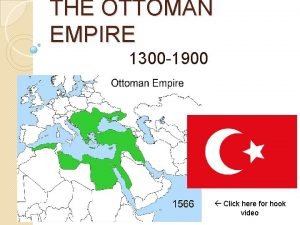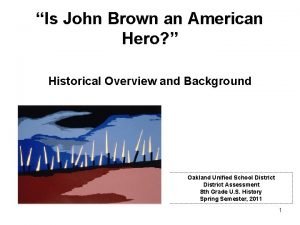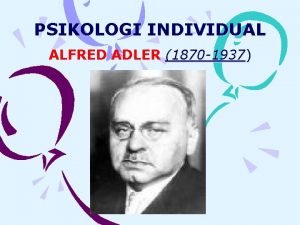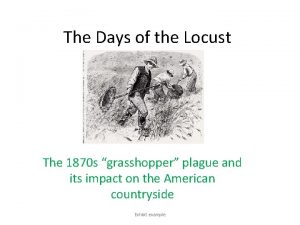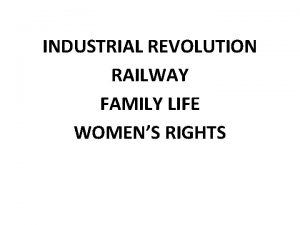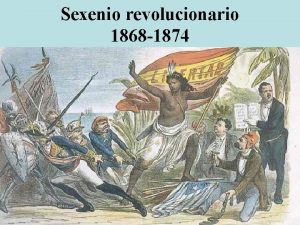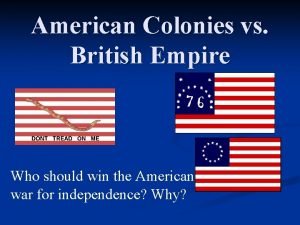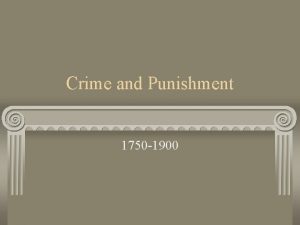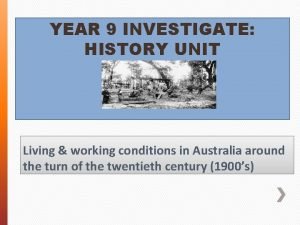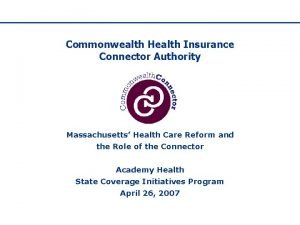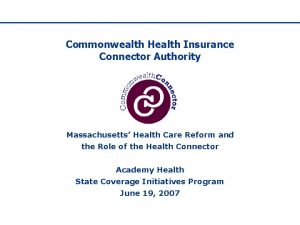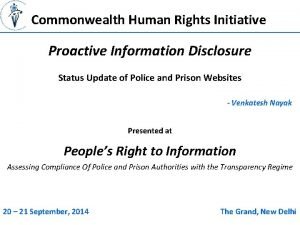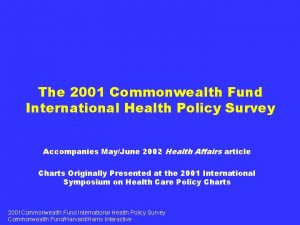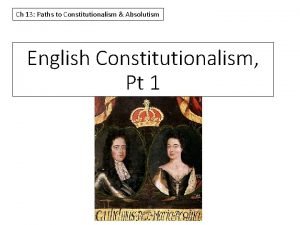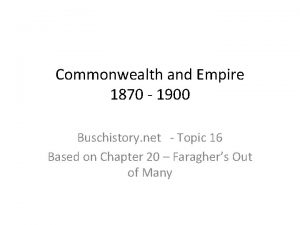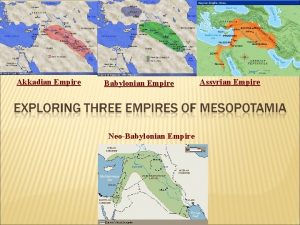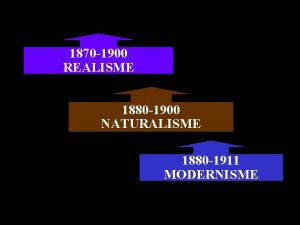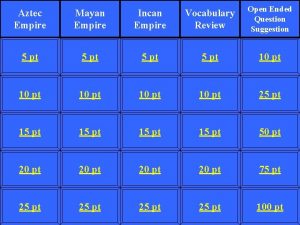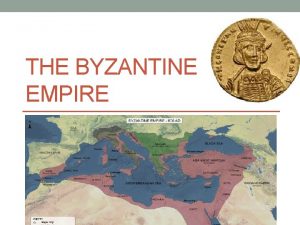Chapter Twenty Commonwealth and Empire 1870 1900 Part






































- Slides: 38

Chapter Twenty Commonwealth and Empire, 1870– 1900

Part One: Introduction

Commonwealth and Empire What does this painting suggest about American expansion?

Chapter Focus Questions What characterized the growth of federal and state governments and the consolidation of the modern twoparty system? How did mass protest movements develop? What was the economic and political crisis of the 1890 s? How did the United States develop as a world power? What were the causes and outcomes of the Spanish. American War?

Part Two: American Communities

The Cooperative Commonwealth Edward Bellamy’s Looking Backward described a utopian society in which the economy was under the collective ownership of the people. People enjoyed short workdays, long vacations, and retired at age 45. The Point Loma community was established near San Diego in 1897. It was a communal society that provided both private and shared housing. No one earned wages. The men sought self-sufficiency through agriculture while the women made clothing to be worn. The members of the community shared two meals a day and spent leisure time together. Donations from admirers and wealthy members allowed the community to last for decades.

Part Three: Toward a National Governing Class

The Growth of Government The size and scope of government at all levels grew rapidly during the gilded age. New employees, agencies, and responsibilities changed the character of government. Taxes increased as local governments assumed responsibility for providing such vital services as police, fire protection, water, schools, and parks.

The Machinery of Politics The federal government developed its departmental bureaucracy. Power resided in Congress and the state legislatures. The two political parties only gradually adapted to the demands of the new era. Political campaigns featured mass spectacles that reflected the strong competition for votes. Political machines financed their campaigns through kickbacks and bribes and ensured support by providing services for working-class neighborhoods. Offices were filled by the spoils system that rewarded friends of the winning party.

The Spoils System and Civil Service Reform In 1885, Congress passed the Pendleton Civil Service Reform Act that created the civil service system and a professional bureaucracy. A system of standards was developed for certain federal jobs. This effort paralleled similar efforts at professionalism in other fields. The legislative branch was also given a more active role in government under the Circuit Court of Appeals Act of 1891.

Part Four: Farmers and Workers Organize Their Communities

The Grange Farmers and workers built movements that challenged the existing system. The Grange formed in the 1870 s by farmers in the Great Plains and South who suffered boom and bust conditions and natural disasters. Grangers blamed hard times on a band of “thieves in the night, ” especially railroads, and pushed through laws regulating shipping rates and other farm costs. Grangers created their own grain elevators and set up retail stores for farm machinery. The depression of the late 1870 s wiped out most of these programs.

The Farmers’ Alliance In the late 1880 s, Texas farmers, led by Charles W. Macune, formed the National Farmers Alliance and Industrial Union, in cooperation with the Colored Alliance. The Alliance sought to: challenge the disproportionate power of the governing class restore democracy establish a cooperative economic program Northern Plains farmer organizations soon joined the Alliance. Midwestern farm groups battled railroad influence. By 1890, the Alliance was a major power in several states demanding demanded a series of economic reforms.

Workers Search for Power In 1877, a “Great Uprising” shut down railroads all across the country. Federal troops were called out, precipitating violence. Government created national guards to prevent similar occurrences. Workers organized stronger unions that increasingly resorted to strikes and created labor parties. Henry George ran for mayor of New York on the United Labor Party ticket and finished a respectable second. In the late 1880 s, labor parties won seats on numerous city councils and in state legislatures in industrial areas where workers outnumbered other classes. Map: Strikes by State 1880

Women Build Alliances Women actively shaped labor and agrarian protest. The Knights included women at their national convention and even ran day-care centers and baking cooperatives. Women were active members in the Grange and Alliances. The greatest female leader was Frances E. Willard, who: was president of the Women’s Christian Temperance Union mobilized nearly 1 million women to promote reform and to work for women’s suffrage

Populism and the People’s Party Between 1890 and 1892, the Farmers’ Alliance, the Knights of Labor, the National Colored Farmers’ Alliance and other organizations formed the People’s Party. The People’s Party platform called for: government ownership of railroads, banks, and the telegraph the eight-hour day the graduated income tax, and other reforms Though the party lost the 1892 presidential race, Populists elected three governors, ten congressional representatives, and five senators.

Part Five: The Crisis of the 1890 s

The Depression of 1893 In 1893, the collapse of the nation’s major rail lines precipitated a major depression. Full recovery was not achieved until the early 1900 s. Unemployment soared and many suffered great hardships. Tens of thousands took to the road in search of work or food. Jacob Coxey called for a march on Washington to demand relief through public works programs. “Coxey’s Army” was greeted warmly by most communities on the way to Washington. The attorney general, who was a former lawyer for a railroad company, conspired to stop the march. Police clubbed and arrested the marchers for trespassing on the grass in Washington.

Strikes: Coeur d’Alene, Homestead, and Pullman Strikes were sparked by wage cuts, longer work days, and big business attempts to destroy unions. In Idaho, a violence-plagued strike was broken by federal and state troops. The miners formed the Western Federation of Miners. The hard times precipitated a bloody confrontation at Andrew Carnegie’s Homestead steel plant. A major strike in Pullman, Illinois: spread throughout the nation’s railroad system ended with the arrest of Eugene Debs resulted in bitter confrontations between federal troops and workers in Chicago and other cities.

The Social Gospel A “social gospel” movement led by ministers such as Washington Gladden, called for churches to fight against social injustice. Charles M. Sheldon urged readers to rethink their actions by asking: “What would Jesus do? ” The Catholic Church endorsed the right of workers to form trade unions. Immigrant Catholic groups urged priests to ally with the labor movement. Women’s religious groups such as the YWCA (Young Women’s Christian Association) strove to provide services for poor women.

The Free Silver Issue Grover Cleveland won the 1892 election by capturing the traditional Democratic Solid South and German voters alienated by Republican nativist appeals. When the economy collapsed in 1893, government figures concentrated on longstanding currency issues to provide a solution. The debate was over hard money backed by gold or soft money backed by silver. Cleveland favored a return to the gold standard, losing much popular support.

Populism's Last Campaign The hard times strengthened the Populists, who were silver advocates. They recorded strong gains in 1894. But in 1896, when the Democrats nominated William Jennings Bryan as a champion of free silver, Populists decided to run a fusion ticket of Bryan and Tom Watson. Republicans ran William Mc. Kinley as a safe alternative to Bryan. Republicans characterized Bryan as a dangerous man who would cost voters their jobs.

The Election of 1896 Map: Election of 1896 Bryan won 46% of the vote but failed to carry the Midwest, Far West, and Upper South. Traditional Democratic groups like Catholics were uncomfortable with Bryan and voted Republican. The Populists disappeared and the Democrats became a minority party. Mc. Kinley promoted a mixture of pro-business and expansionist foreign policies. The return to prosperity after 1898 insured continued Republican control.

Part Six: The Age of Segregation

Nativism and Jim Crow Chart: African American Representation in Congress Neither Mc. Kinley nor Bryan addressed the increased racism and nativism throughout the nation. Nativists blamed foreign workers for hard times and considered them unfit for democracy. The decline of the Populist party led to the establishment of white supremacy as the political force in the Southern whites enacted a system of legal segregation and disenfranchised blacks, approved by the Supreme Court. Reformers abandoned their traditional support for black rights and accepted segregation and disenfranchisement.

Mob Violence and Lynching Racial violence escalated. Between 1882 and 1900 lynchings usually exceeded a hundred each year. They were announced in newspapers and became public spectacles. Railroads offered special excursion prices to people traveling to attend lynchings. Postcards were often printed as souvenirs. Ida B. Wells launched a one-woman anti-lynching crusade. She argued that lynching was a brutal device to get rid of African Americans who were becoming too powerful or prosperous.

Part Seven: “Imperialism of Righteousness”

The White Man’s Burden Many Americans proposed that the economic crisis required new markets for American production. Others suggested Americans needed new frontiers to maintain their democracy. The Chicago World’s Fair: showed how American products might be marketed throughout the world reinforced a sense of stark contrast between civilized Anglo-Saxons and savage people of color. A growing number of writers urged America to take up the “White Man’s Burden. ” Clergymen like Josiah Strong urged Americans to help Christianize and civilize the world.

Foreign Missions After the Civil War, missionary activity increased throughout the non-western world. College campuses blazed with missionary excitement. The YMCA and YWCA embarked on a worldwide crusade to reach non-Christians. Missionaries helped generate public interest in foreign lands and laid the groundwork for economic expansion.

An Overseas Empire Map: “An American Domain” Beginning in the late 1860 s, the United States began expanding overseas. Secretary of State William Henry Seward launched the nation’s Pacific empire by buying Alaska and expanding the United States presence in Hawaii. The U. S. policy emphasized economic control, particularly in Latin America. During the 1880 s and 1890 s, the United States strengthened its navy and began playing an increased role throughout the Western Hemisphere and the Pacific.

Hawaii The United States annexed Hawaii in 1898. Hawaii was a stepping-stone to Asian markets. In 1899, Secretary of State John Hay proclaimed the Open Door policy in Asia to ensure American access and laid the basis for twentieth-century foreign policy.

Part Eight: The Spanish-American War

The United States and Cuba A movement to gain independence from Spain began in the 1860 s. Americans sympathized with Cuban revolutionaries. The Spanish were imposing harsh taxes. By 1895, public interest in Cuban affairs grew, spurred on by grisly horror stories of Spanish treatment of revolutionaries. Mc. Kinley had held off intervention, but public clamor grew following an explosion on the USS Maine. Humphrey and George Wallace.

A “Splendid Little War” in Cuba Map: The Spanish-American War The United States smashed Spanish power in what John Hay called “a splendid little war. ” The Platt Amendment protected U. S. interests and acknowledged its unilateral right to intervene in Cuban affairs. This amendment paved the way for U. S. domination of Cuba’s sugar industry and provoked anti-American sentiments among Cuban nationals. The United States also annexed a number of other Caribbean and Pacific islands including the Philippines.

War in the Philippines Initially, Filipino rebels welcomed American troops in their fight against Spain. After the United States intended to annex their country, they turned against their former allies. Between 1899 and 1902, Americans fought a war that led to the death of one in every five Filipinos. Supporters defended the war as bringing civilization to the Filipinos. Critics saw the abandonment of traditional support for selfdetermination and warned against bringing in dark-skinned people.

Critics of Empire The Filipino war stimulated the founding of an Anti-Imperialist League that denounced the war and territorial annexation in no uncertain terms. Critics cited democratic and racists reasons for anti-imperialism. Most Americans put aside their doubts and welcomed the new era of aggressive nationalism.

Part Nine: Conclusion

Commonwealth and Empire Media: Chronology
 Ottoman empire in 1900
Ottoman empire in 1900 Ottoman empire map in world map
Ottoman empire map in world map Ottoman empire 1750
Ottoman empire 1750 Strengths and weaknesses of the forster act 1870
Strengths and weaknesses of the forster act 1870 Capital of kansas
Capital of kansas Venn diagram of mauryan and gupta empires
Venn diagram of mauryan and gupta empires Fictional finalism bersifat
Fictional finalism bersifat Maria montessori (1870-1952)
Maria montessori (1870-1952) Halyna kuzmenko
Halyna kuzmenko Frise chronologique 1815 à 1870
Frise chronologique 1815 à 1870 Frise chronologique 1815 à 1870
Frise chronologique 1815 à 1870 1870 locust plague
1870 locust plague 1870
1870 Over land by rail’, gustave dore, 1870
Over land by rail’, gustave dore, 1870 Rey de españa entre 1870 y 1873
Rey de españa entre 1870 y 1873 American empire vs british empire
American empire vs british empire Ancient rome recreation
Ancient rome recreation Crime and punishment 1750 to 1900
Crime and punishment 1750 to 1900 Living and working conditions in australia 1900
Living and working conditions in australia 1900 Commonwealth swimming pool
Commonwealth swimming pool Commonwealth population
Commonwealth population Commonwealth connector
Commonwealth connector Commonwealth health insurance connector authority
Commonwealth health insurance connector authority What does being british mean to you
What does being british mean to you Executive order no. 263 s. 1940
Executive order no. 263 s. 1940 Commonwealth local government forum
Commonwealth local government forum Proactive commonwealth
Proactive commonwealth Mbampa
Mbampa Commonwealth cyber initiative
Commonwealth cyber initiative Ccc plus waiver
Ccc plus waiver Workplace readiness assessment
Workplace readiness assessment Commonwealth fund mirror mirror
Commonwealth fund mirror mirror Commonwealth funds management
Commonwealth funds management Commonwealth exchange programme
Commonwealth exchange programme Commonwealth fund international health policy survey
Commonwealth fund international health policy survey Spbp application
Spbp application Commonwealth
Commonwealth Workplace readiness skills for the commonwealth
Workplace readiness skills for the commonwealth Commonwealth of australia
Commonwealth of australia
